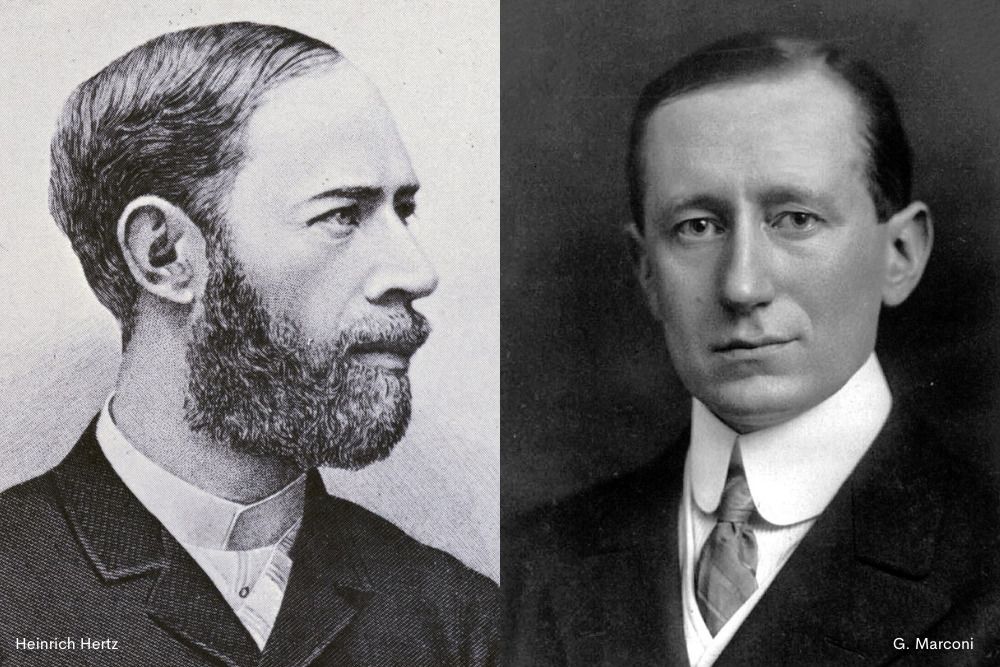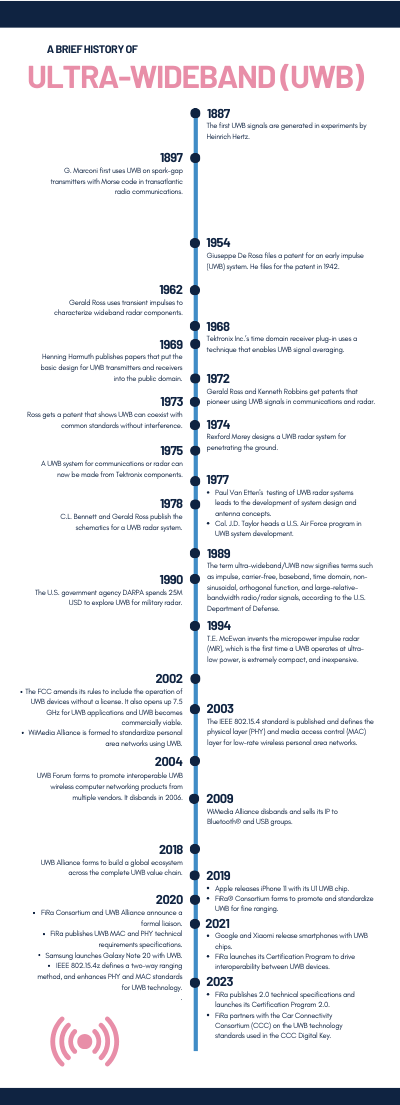
The history of ultra-wideband (UWB) is both new and old. While the initial seeds of UWB were first planted in the late 19th century, it’s only in the past couple of decades that the technology has really grown and taken hold.
What is the History of UWB?
The Origins
UWB traces its origins back to the early age of radio. Two men in the late 1800s had a major impact on radio technology: Heinrich Hertz and Guglielmo Giovanni Maria Marconi. Hertz generated the first UWB signals in 1887 by creating sparks and radiating them via wide-band loaded dipoles. This was the first experimental spark-gap transmitter.

In 1896, Marconi took this a step further by spreading a signal over a very wide bandwidth. His discovery led to transatlantic radio communications and military radio applications using Morse code. Even though these impulse signals were the forerunners of modern UWB communications, the wide bandwidth didn’t allow for sharing, so it was eventually abandoned for narrowband communications.
UWB History in the 20th Century
UWB Advances Throughout ‘60s and ‘70s
The technology was shelved for decades until modern test equipment rekindled interest in impulse radio development. In 1942, Giuseppe De Rosa applied for a patent for an early impulse (UWB) system. He didn’t actually receive the patent until 1954. Eight years later, Gerald Ross used transient impulses to characterize wideband radar components using the newly invented sampling oscilloscope.
Thanks to other inventions like Tektronix’s time domain receiver plug-in model and its Tektronix System that used a technique to enable UWB signal averaging in 1968, UWB continued to develop. This included Henning Harmuth publishing papers that put the basic design for UWB transmitters and receivers into the public domain a year later.
UWB advancement continued in the 1970s when Gerald Ross and Kenneth Robbins had patents issued that pioneered using UWB signals in communications and radar in 1972. The next year, Ross obtained another patent that showed UWB could coexist with common standards without interference. Other progress in the ‘70s included a UWB radar system for penetrating the ground; UWB communications and radar systems made from Tektronix components; published schematics for a UWB radar system; and the U.S. Air Force development of a program that utilized UWB.
Welcome Ultra-Wideband
1989 was a big year for UWB. The U.S. Department of Defense coined the term “ultra-wideband” to signify terms like impulse, carrier-free, baseband, time domain, and much more. The following year, the U.S. government agency DARPA spent 25M USD to explore UWB for military radar. And in 1994, T.E. McEwan invented the micropower impulse radar which was the first time UWB operated at ultra-low power and was found to be extremely compact and inexpensive.
The new millennium has so far been an extremely important era for UWB. In 2002, The FCC updated its Part 15 rules which enabled the operation of UWB devices without a license. The organization identified UWB signals as having a fractional bandwidth of greater than 0.20 or a UWB bandwidth greater than 500MHz. This meant that UWB became commercially viable and could operate at low power in an unlicensed spectrum from 3.1 to 10.6 GHz. Several months later on the tail of this evolution, the not-for-profit open industry forum WiMedia Alliance was created to develop and adopt standards-based specifications for connecting personal area wireless multimedia devices.
UWB Picks Up Speed in the 2000s
Establishing Standards
The following year, 2003, UWB took a leap forward when the Institute of Electrical and Electronics Engineers (IEEE) published IEEE 802.15.4, which defined the physical (PHY) layer and the media access control (MAC) layer for low-rate wireless personal area networks. It wasn’t long until the UWB Forum was established to ensure UWB products were interoperable and help facilitate the worldwide regulatory approval process for UWB systems. Unfortunately, the organization disbanded in 2006, as did the WiMedia Alliance followed suit three years later. When established in 2019, the UWB Alliance helped fill the void with a focus on providing a favorable regulatory and spectrum management landscape to maximize UWB growth.
UWB became more mainstream when Apple released its iPhone 11 with its UWB U1 chip in 2019. One month later, the FiRa® Consortium was founded to promote and standardize UWB for fine-ranging with a commitment to fostering the widespread adoption of UWB-driven applications.
The next few years were momentous for UWB and for FiRa. In 2020, IEEE 802.15.4z standard was published to enhance the PHY and MAC standards for UWB technology. The same year Samsung launched its Galaxy Note 20 with UWB. For FiRa, 2020 saw the organization publish its UWB PHY and MAC technical requirements specifications. It also formed a formal liaison with the UWB Alliance.
A year later, FiRa launched its UWB Certification Program to drive interoperability between UWB devices. Also, more technology companies jumped on the UWB bandwagon in 2021. Google released its Pixel 6 and Xiaomi released its MIX 4 smartphones – both with UWB chips.
2023 and Beyond
Last year was a productive one for FiRa. It published its 2.0 technical specifications and launched its 2.0 Certification Program. In addition, FiRa and the Car Connectivity Consortium (CCC) created a significant partnership focused on the UWB technology specifications used in the CCC Digital Key.
As UWB-enabled products, applications, and use cases continue to embrace the consumer market, it won’t be long until the term becomes synonymous with Bluetooth® and Wi-Fi. Once you learn about its rollercoaster evolution, it appears the UWB revolution not only growing, it’s here to stay.